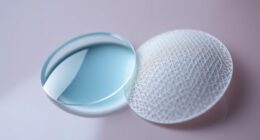Decoding hair porosity tests helps you understand how well your hair absorbs and holds moisture. By identifying if you have high, medium, or low porosity, you can choose products and routines that work best for your hair type. This saves time, reduces frustration, and improves hair health. Knowing your porosity is key to managing dryness, frizz, or buildup. Keep exploring to discover simple ways to determine your hair’s porosity and reveal your best hair care routine.
Key Takeaways
- Hair porosity tests identify how well hair absorbs and retains moisture, guiding personalized hair care routines.
- Common tests include the float test, slide test, and burn test, each revealing different porosity levels.
- Knowing your hair’s porosity helps select appropriate products, improving hydration, manageability, and overall hair health.
- Proper testing prevents product buildup or dryness by matching treatments to your hair’s specific needs.
- Understanding porosity is crucial for achieving optimal results and maintaining healthy, manageable hair over time.

Ever wonder what your hair’s porosity really means for its health and styling? Understanding your hair porosity is key to tailoring your hair care routine effectively. Porosity determines how well your hair absorbs and retains moisture, which directly impacts how products work on your strands and how healthy they remain over time. When you know your porosity level, you can choose products that either penetrate deeply or sit on the surface, helping you achieve the best results with less frustration.
High porosity hair tends to have gaps or holes in the cuticle, making it easy for moisture to escape but difficult to retain. If your hair falls into this category, it might absorb products quickly but lose moisture just as fast. This can leave your hair feeling dry, brittle, or frizzy, especially if you’re using heavy or incompatible products. Conversely, low porosity hair has tightly closed cuticles that resist moisture and product absorption. It often appears shiny and healthy but struggles to absorb conditioners or treatments, leading to product buildup and insufficient hydration.
Knowing your porosity level helps you optimize your product application. For high porosity hair, lightweight, hydrating products with humectants like glycerin or aloe vera work best to lock in moisture. You want to avoid heavy oils or silicones that can sit on the surface without penetrating. For low porosity hair, you’ll benefit from heat or steaming to open the cuticles, allowing conditioners and treatments to penetrate more effectively. Light, water-based products are ideal since they can seep in without weighing your hair down.
The way your hair interacts with products — its absorption and moisture retention — is a direct reflection of your porosity. When you use the right products for your level, you’ll notice better manageability, less frizz, and improved overall hair health. Additionally, understanding how automation in business can streamline your hair care routine—such as through personalized recommendations or digital tools—can save you time and effort. Conversely, using incompatible products can lead to buildup, dryness, or uneven results. That’s why understanding your porosity isn’t just about styling; it’s about caring for your hair’s health. It guides you to choose the right ingredients and application methods, saving you time, money, and frustration.
In essence, decoding your hair’s porosity is a simple yet powerful step toward personalized hair care. When you align your routine with your hair’s unique needs, you give your strands the best chance to stay moisturized, shiny, and strong. It’s about working smarter, not harder, so your hair can look and feel its absolute best every day.
Frequently Asked Questions
How Often Should I Test My Hair Porosity?
You should perform hair porosity testing every few months to stay updated on your hair’s needs. Frequency recommendations suggest testing every 3 to 6 months, especially if you notice changes in moisture retention or damage. Regular hair porosity testing helps you adjust your hair care routine accordingly, ensuring your products and treatments work effectively. Keep an eye on your hair’s response, and don’t hesitate to test more often if you notice shifts in its condition.
Can Hair Porosity Change Over Time?
Think of your hair as a living river, constantly changing course. Yes, hair porosity can change over time due to factors like damage or product buildup. Many hair porosity myths suggest it’s fixed, but porosity testing methods reveal it’s more fluid than you might think. Staying aware helps you adapt your hair care routine, ensuring your strands stay healthy and vibrant regardless of how your hair’s journey evolves.
Does Porosity Affect Hair Color Treatments?
Porosity can definitely affect your hair color treatments. High porosity hair absorbs color more quickly but may fade faster, while low porosity hair resists color uptake. This impacts your hair strength and scalp health because overprocessing can weaken strands or cause irritation. Understanding your porosity helps you choose the right products and techniques, ensuring your hair remains healthy and vibrant after treatments.
Are There Natural Ways to Improve Hair Porosity?
Some believe natural methods can improve hair porosity, but results vary. You might try DIY remedies like deep conditioning with natural oils or apple cider vinegar rinses, which can temporarily seal cuticles. Nutritional factors also matter—eating a balanced diet rich in vitamins A, C, and E supports healthy hair. While these approaches can help, consistency is key, and results depend on your hair’s unique porosity level.
What Products Are Best for Different Porosity Levels?
You should choose products based on your hair’s porosity level for the best results. For low porosity hair, opt for lightweight, water-based products that help penetrate the cuticle. Medium porosity benefits from balanced moisturizers and protein treatments, while high porosity needs heavier creams and sealants to lock in moisture. Focus on porosity matching when selecting products, ensuring they nourish and protect your hair effectively.
Conclusion
Understanding your hair’s porosity helps you tailor your hair care routine effectively. When you know how your hair absorbs and retains moisture, you can choose the right products and techniques. Remember, knowledge is power—“A little knowledge is a dangerous thing,” but in this case, it’s your best tool. By decoding your hair porosity, you’re taking control and giving your hair the love it needs to thrive. The right care starts with understanding what your hair truly needs.








